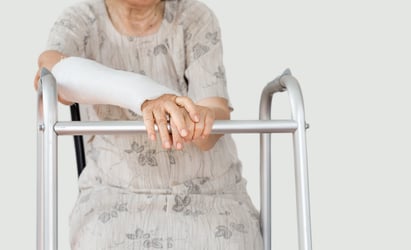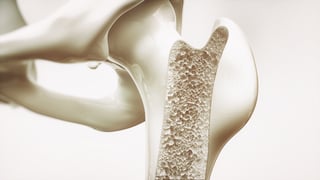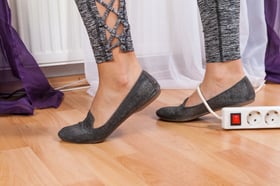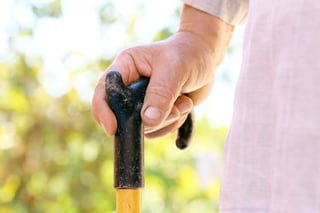
One of the most common medications prescribed to treat Chronic Obstructive Pulmonary Disease (COPD) are corticosteroids. These medications ease inflammation in the airways, reducing swelling and the production of mucus, thereby alleviating symptoms.
Corticosteroids and Bone Density Loss
Over the past few years there has been much discussion about the link between  extended corticosteroid use and the risk of hip fracture. This 2016 study conducted In Taiwan showed that there was common comorbidity between corticosteroid use and loss of bone density, or osteoporosis. More recently a study reported by CHEST utilized Quebec Health Care databases to track whether those diagnosed with COPD from 1990 to 2005 and were prescribed corticosteroids had an increased instance of hip or upper extremity fracture. Such a link was found to exist. Increased bone loss or osteoporosis is already known to be elevated in post-menopausal women and those who utilize corticosteroids have an even higher occurrence of fracture.
extended corticosteroid use and the risk of hip fracture. This 2016 study conducted In Taiwan showed that there was common comorbidity between corticosteroid use and loss of bone density, or osteoporosis. More recently a study reported by CHEST utilized Quebec Health Care databases to track whether those diagnosed with COPD from 1990 to 2005 and were prescribed corticosteroids had an increased instance of hip or upper extremity fracture. Such a link was found to exist. Increased bone loss or osteoporosis is already known to be elevated in post-menopausal women and those who utilize corticosteroids have an even higher occurrence of fracture.
The Good News is Two-Fold
- First of all, the increased risk is not drastic.
- Secondly, there are measures you can take to both cut your risk of fracture and curb bone loss.
Causes for Falls
Most fractures, especially among higher age groups, occur in the home. Falls are the number one cause of injures in seniors and it is estimated that 1 in 3 seniors will take a fall this year. Here are some common causes of falling:
Balance issues: over time we can lose some coordination and flexibility making it easier to fall.
Medication reactions: some medications can cause dizziness or other reactions that may lead to loss of balance. Some also contribute to loss of motor functions.
Poor Vision: as we age our ability to see in dim light often diminishes making it easier to trip or misjudge distance.
Environment: if we’ve lived somewhere for a long time it’s easy to overlook things that need to be repaired or modified but these things can become dangerous one day when we’re not paying attention or for a visitor who is not used to avoiding them.
Health Factors: diabetes, arthritis, or other chronic conditions often contribute to dizziness, vertigo, or their balance problems and increase our risk of falls.
Common Fall Hazards
- Tripping over rugs, cords, or items left on the floor that shouldn’t be there.

- Water, soap, oil, or other slippery liquids, especially in the bathroom or kitchen, can be hazardous (this can come from cooking spray, so make sure to spray any pans over the sink)!
- Falls on stairwells can be particularly dangerous.
- Fractures can also occur from heavy items falling on someone.
Home Safety
To prevent fractures at home take these easy precautions:
- Limit use of area rugs as they can be tripping hazards. If they must be used make sure that corners lay flat and there are no wrinkles or bulges.
- Clean up spills immediately.
- Use a bathmat to prevent water from pooling in the bathroom.
- Make sure shower curtain or door is in good repair and prevents water from dripping on the floor.
- Install a hand rail in the shower or bathtub for those who might need help steadying themselves while getting in and out.
- Affix non slip tread at the bottom of the shower or tub to prevent slipping.
- Consider getting a shower bench for those who might find it difficult to stand for long periods of time or those with dizziness problems.
- Use cord protectors if power or phone cords are present in walkways.
- Don’t walk around in just socks as they are too slippery. Wear shoes or slippers with rubber soles in the house.
- Clear clutter! Don’t leave things on the floor to trip over.
- Absolutely no unsecured rugs on stairwells. Ensure that stairs are well lit and that there is a sturdy handrail.
- Put highlights in bathrooms or in hallways so that if you have to go into the hall or bathroom in the middle of the night, you can see where you are going.
- Don't store heavy items overhead or where they are difficult to get too. Ensure storage shelving is in good repair.
Precautions Must be Taken in Outdoor Areas Too
- Ensure lawns are in good repair with no branches laying around to trip over or holes to twist your ankle.
- In winter keep sidewalks shoveled and throw down ice melt.
- Sweep up gravel on concrete to prevent slipping.
When You’re Out and About
When you are out running errands or attending social functions there are certain  precautions you can take as well.
precautions you can take as well.
- Wear properly fitted clothing so that you don’t trip over hems that are too long or catch yourself on loose jackets or shirts.
- Use a cane or walker if needed. Don’t let vanity make you end up in the hospital or with a permanent injury.
- Fill out necessary paperwork to get a handicap placard if parking closer to facilities will help keep you safe.
The NCOA or National Council on Aging recognizes the incredible risk that falls present to our aging population. As a result they have instituted a fall prevention program. There you will find a vast library of articles and videos on how to prevent falls and bolster home safety. They talk about everything from proper nutrition, to hazards in the home, to exercises to improve balance. All items are free to access.
In an effort to keep all of our patients thriving and healthy we will be covering this issue all week. We hope you learn some valuable tips on keeping yourself and loved ones safer.





 precautions you can take as well.
precautions you can take as well.
